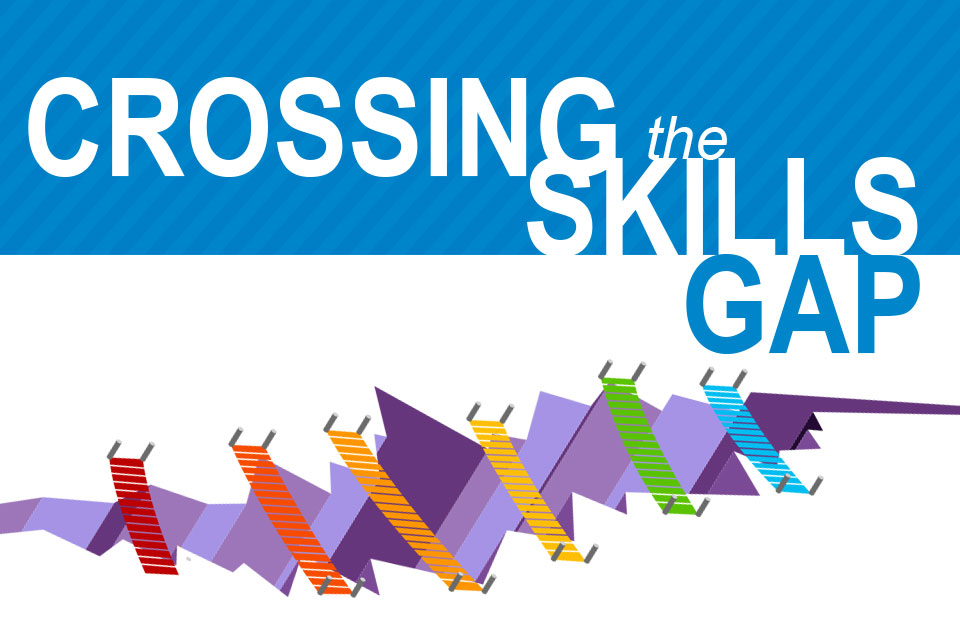You may have received a call to action to address the skills gap, which might feel making a bridge across the Grand Canyon with a few sticks and some string. The overarching term, “skills gap,” encompasses a variety of workplace topography with very different types of solutions. Perhaps, because of its large scale “skills gap” doesn’t come close to identifying the specific scope or the needs of your organization. The problem may lie in defining what the problem really is.
How do you define a skills gap?
There are a variety of reasons for the rift between matching people with available jobs.
The Technology Gap
Robotics, artificial intelligence, and other advanced technologies may pose one of two types of concerns. Either your facility is expanding toward the future and your people have skill shortages, or your facility is crawling toward these endeavors and you can’t keep your people from being lured away.
The 2018 Deloitte Skills Gap and Future of Work in Manufacturing Study, states that “The types of skills that employees need to possess are rapidly evolving, and it seems increasingly difficult for the workforce to keep pace.“
If your facility has embraced AI and robotics in the workplace, educational bridges for these gaps may already be started. If this technology is still in a galaxy far, far away, perhaps first laying a foundational understanding of the basics the technology is addressing is a timelier approach for your current workers.
The Perception Gap
Misconceptions of what a career in your industry involves could be adding to your labor shortage. The Forbes article, Manufactured Perceptions: Why Industry Needs To Reset Its Reputation, states, “It’s these misperceptions that exacerbate the skills shortage we’re facing, as young people, their parents and guidance counselors don’t see manufacturing as a viable career path.”
Get onboard with an organization that is tackling the manufacturing myth for the workforce of tomorrow or start your own. Host a manufacturing day with a local school or community college and find ways to get employees involved. A group of like-minded change-makers can more readily organize and propose a paradigm shift, even if it is just within your facility or town.
The Knowledge Gap
Aging and subsequent generation identity are important issues in the world of manufacturing. Knowledge and experience are leaving and may not be handed off. A new generation of workers grew up with a very different landscape of tools and methods of learning. In training, these new learners may struggle with a mentor approach that can be sporadic in conveying information.
How do you make strides across the knowledge gap?
Laying a strong foundation of training in the basics for your industry can be an important supporting tool for bridging the gap. If the chasm you are facing is related to the preparation of various levels of experience, THORS courses can help. We understand that each of these training goals present their own challenges.
- Onboard: Accelerate learning by blending our courses with your training. New workers come prepared with a baseline of fundamentals you can build on.
- Upskill: Help eager learners advance within your organization.
- Reskill: Keep the worker, change their focus or department.
- Knowledge transfer: Capture key knowledge from retirees before they leave with THORS’ custom availability.
- Retain: Provide a culture of learning for growth and satisfaction. Learners equipped with understanding are more productive, more confident, and have a better morale to stick around.
- Cross-train: Improve job performance and collaboration by enhancing overall understanding of products and services across diverse roles.

What is the first step?
THORS CEO and Founder, Senthil Kumar, explains how knowledge is used as the foundation for skill building. “The first thing taught is terminology. “From there, we build an understanding of the process and then cover how to apply the knowledge.”
Kumar says, “many training programs focus on teaching how to do something, but the “what” and “why” are crucial to understanding an entire process.” The understanding of the foundation allows for more creative problem-solving.
Once workers understand the terminology outside of their immediate responsibilities and department, they can have more effective conversations and collaboration with coworkers—“because now they understand what’s going on upstream and downstream from what they do,” Kumar says.
Perhaps by addressing the specific and relevant gap being faced, building a bridge across the skills gap can feel less like a daunting canyon and more like a manageable span over a narrow gulley.
We want to hear from you! Let’s discuss how THORS can aid in identifying and being a resource in your training operations.



